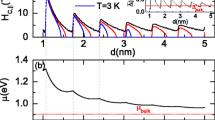Abstract
The size dependences of the Fermi energy of metallic films of Al and Pb bordering with the dielectrics SiO2, Al2O3, HfO2, ZrO2, and TiO2 have been calculated. The model of free electrons and an asymmetric potential well has been modified by the introduction of the effective masses of electrons in the metal and in the insulator. The evolution of the size oscillations of the Fermi energy of metallic films in different dielectric surroundings upon the variation of the effective masses of electrons both in the metal and in the insulator has been analyzed. It has been shown that the allowance for the effective mass of electrons in the metal leads to a more substantial change in the position of the Fermi level in comparison with the allowance for the effective mass of the dielectric.
Similar content being viewed by others
References
M. Hövel, B. Gompf, and M. Dressel, “Electrodynamics of ultrathin gold films at the insulator-to-metal transition,” Thin Solid Films 519, 2955–2958 (2011).
M. G. del Muro, Z. Konstantinovic, X. Batlle, and A. Labarta, “From capacitive to tunnelling conduction through annealing in metal–insulating granular films: The role of ultra-small particles,” J. Phys. D: Appl. Phys. 46, 495304 (2013).
J. Mandrino, M. Godec, and D. Nolan, “Oxide-state evaluation of the zinc and aluminum in metallic thin films using Auger-electron-spectroscopy depth profiles,” Vacuum 98, 88–92 (2013).
R. Sh. Ikhsanova, V. E. Babicheva, I. E. Protsenko, A. V. Uskov, and M. E. Guzhva, “Bulk photoemission from metal films and nanoparticles,” Quant. Electron. 45, 50–58 (2015).
V. V. Pogosov, A. V. Babich, and P. V. Vakula, “On the influence of the band structure of insulators and image forces on the spectral characteristics of metal–insulator film systems,” Phys. Solid State 55, 2120–2123 (2013).
A. V. Babich, “On calculating the energy characteristics of a metal film with a dielectric coating,” Phys. Met. Metallogr. 115, 107–116 (2014).
A. V. Korotun, “Size oscillations of the work function of a metal film on a dielectric substrate,” Phys. Solid State 57, 391–394 (2015).
V. P. Kurbatsky and V. V. Pogosov, “Optical conductivity of metal nanofilms and nanowires: The rectangularbox model,” Phys. Rev. B: Condens. Matter Mater. Phys. 81, 155404 (2010).
W. A. Harrison, Solid State Theory (McGraw-Hill, New York, 1969; Mir, Moscow, 1972).
A. O. E. Animalu, Intermediate Quantum Theory of Crystalline Solids (Prentice Hall, Englewood Cliffs, NJ, 1977; Mir, Moscow, 1981).
N. B. Brandt and V. A. Kul’bachinskii, Quasi-particles in Condensed Matter Physics (Fizmatlit, Moscow, 2010), 3rd ed. [in Russian].
T. V. Perevalov and V. A. Gritsenko, “Application and electronic structure of high-permittivity dielectrics,” 53, 561–575 (2010).
A. V. Babich, V. V. Pogosov, and P. V. Vakula, “To the problem of positron states in metal–insulator nanosandwiches,” Phys. Solid State 57, 142–147 (2015).
V. P. Kurbatskii, A. V. Korotun, V. V. Pogosov, and E. V. Vasyutin, “Size dependence of the transmittance for metal nanofilms in the infrared range,” Phys. Solid State 50, 949–956 (2008).
V. Fomenko, Emission Properties of Chemical Elements and Their Compounds (Naukova Dumka, Kiev, 1980) [in Russian]; Handbook of Thermionic Properties: Electronic Work Functions and Richardson Constants of Elements and Compounds (New York: Plenum, 1966).
C. Fall, “Ab initio study of the work functions of elemental metal crystals,” These No. 1955 pour l’obtention du grade de doctor ès sciences (EPFL, Lausanne, 1999).
J. H. Dil, J. W. Kim, Th. Kampen, K. Horn, and A. R. H. F. Ettema, “Electron localization in metallic quantum wells: Pb versus In on Si(111),” Phys. Rev. B: Condens. Matter Mater. Phys. 73, 161308 (2006).
Y. Yee-Chia, T.-J. King, and H. Chenming, “Direct tunneling leakage current and scalability of alternative dielectrics,” Appl. Phys. Lett. 81, 2091–2093 (2002).
H. Takeuchi and T.-J. King, “Scaling limits of hafnium-silicate films for gate–dielectric applications,” Appl. Phys. Lett. 83 (4), 788–790 (2003).
S. Clima, B. Kaszer, B. Govoreanu, A. S. Verhulst, and M. Jurczak, “Determination of ultimate leakage through rutile TiO2 and tetragonal ZrO2 from ab initio complex band calculations,” IEEE Electr. Device Lett. 34, 402–404 (2013).
V. Mikhelashvili and G. J. Eisenstein, “Effects of annealing conditions on optical and electrical characteristics of titanium dioxide films deposited by electron beam evaporation,” J. Appl. Phys. 89, 3256–3269 (2001).
Z. Xu, L. Pantisano, A. Kerber, R. Degraeve, E. Cartier, S. Degendt, M. Heyns, and G. Groeseneken, “A study of relaxation current in high-κ dielectric stacks,” IEEE Trans. Electron Dev. 51, 402–408 (2004).
J. Kim, J. Song, O. Kwon, S. Kim, Ch. S. Hwang, S.-H. Park, S. J. Yun, J. Jeong, and K. S. Hyun, “Improvement in electrical insulating properties of 10-nm-thick film grown on Al/TiN/Si substrate by remote plasma annealing at low temperatures,” Appl. Phys. Lett. 80, 2734–2736 (2002).
Author information
Authors and Affiliations
Corresponding author
Additional information
Original Russian Text © A.V. Korotun, A.V. Babich, Ya.V. Karandas, 2016, published in Fizika Metallov i Metallovedenie, 2016, Vol. 117, No. 5, pp. 442–445.
Rights and permissions
About this article
Cite this article
Korotun, A.V., Babich, A.V. & Karandas, Y.V. On the influence of the effective mass of electrons on the Fermi energy of metal–insulator nanosandwiches. Phys. Metals Metallogr. 117, 426–429 (2016). https://doi.org/10.1134/S0031918X16050112
Received:
Accepted:
Published:
Issue Date:
DOI: https://doi.org/10.1134/S0031918X16050112




